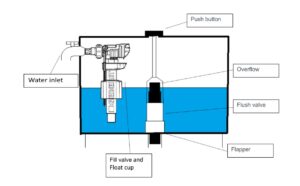To start, have a look at our article on how a toilet flush works. It’ll give you a better understanding of any issues with your flushing mechanism.

The most common causes of flushing problems
Flushing issues often stem from a few common causes, including wear and tear on parts, whether they are broken or deformed, and the build-up of limescale.

Wear and tear of parts:
- Very often, the seals on the water inlet and flapper wear out, leading to leaks. When this happens, you’ll need to replace them.
- The float cup diaphragm can become clogged or cracked, slowing the tank’s refill. Fortunately, this is an easy part to replace.
- If the fill valve is pierced, it can prevent the tank from stopping the water flow. It may need to be replaced, but first, check if it’s simply misaligned.
- The flush lever might break or become dislodged, requiring replacement or refitting.
- In case of a cracked tank, you’ll need to replace it. This is possible to do yourself, though it requires some DIY experience.
- If the flush valve becomes jammed, you can try cleaning it, but it’s likely that the mechanism will need replacing
Limescale:
- Limescale can build up around the flapper, causing a continuous flow of water into the bowl.
- It can also collect on the float cup, slowing the flow of water into the tank.
Limescale can be removed by scrubbing the affected parts and soaking them in an anti-limescale solution (white vinegar works perfectly for this).
The most common problems related to flushing

The toilet tank fills slowly:
This could be due to a malfunctioning fill valve, likely caused by limescale build-up or general wear and tear. Check the condition of the float cup, particularly the diaphragm—if the diaphragm is intact, the fill valve probably needs replacing
The water supply to the toilet doesn’t stop, even when the tank is full:
Once again, this is a problem involving a fill valve that no longer stops the flow of water, which is then gradually drained away through the overflow, resulting in a huge loss of water. This might happen if the float cup is pierced (causing it to stay at the bottom of the tank), or it could be a matter of improper float adjustment.
The toilet flush is leaking into the bowl:
Fisrt, identify where the water is coming from:
- If it is coming from the overflow, the issue is likely with the float cup, which controls how high the water fills in the tank. If cleaning the float cup doesn’t help or if it’s damaged, you’ll need to adjust or replace it.
- If the water is leaking from the flapper, there might be dirt obstructing the seal. Soak the flapper in white vinegar and check the mechanism to ensure everything is functioning properly
Water leaks when closing the toilet lid with the push buttons on:

Looking to replace your flush plate? Consider ordering the Geberit Sigma01, a dual flush model with a round design, made from galvanized fine brass (115.770.DT.5).
This is often a problem that involves the length of the lever that connects the buttons to the mechanism, which can be solved by using plastic levers.
The push button on the toilet no longer works:
This time, the lever that connects the buttons to the flush valve has probably come loose or is broken: it just needs to be replaced or put back in place.
